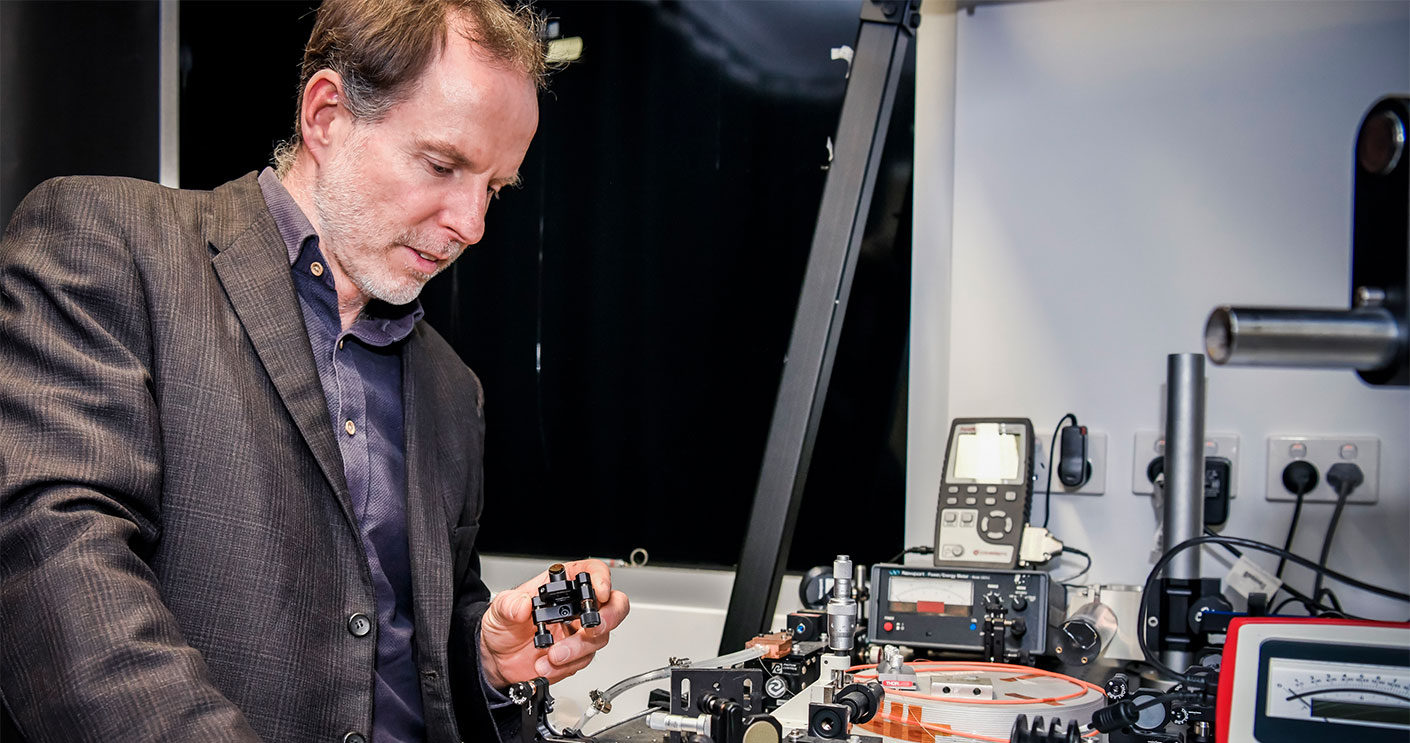Professor Stuart Jackson.
So, how much do you know about lasers? Just one meme-worthy Austin Powers reference and the barcode scanners at Coles, perhaps? Well, luckily, Professor Stuart Jackson and Associate Professor Alex Fuerbach know a whole lot more – so much more, in fact, that the Australian Government has asked them to develop a new kind of laser technology that could protect us from terror attacks.
The two have been awarded a $569K grant in the National Intelligence and Security Discovery Research Grants (NISDRG) scheme, which supports research that deepens understanding of emerging science and technology and addresses intelligence and national security interests. Macquarie is among only eight universities to receive funding in the NISDRG grant round announced by the Minister for Defence last month, with only six per cent of projects successfully funded.
Macquarie’s project – officially called High brightness 2 µm to 20 µm swept wavelength source – will see Alex and Stuart leveraging our world-leading expertise in mid-infrared lasers to develop a compact mid-infrared light source which can be rapidly swept across an entire molecular fingerprint region, enabling a new generation of field-deployable sensor systems to identify biological and chemical threats.
 “Our long-term vision is to develop a complete sensor system that is the size and weight of a shoebox that can be mounted on a lightweight drone,” explains Alex (pictured, right).
“Our long-term vision is to develop a complete sensor system that is the size and weight of a shoebox that can be mounted on a lightweight drone,” explains Alex (pictured, right).
“In a chemical terror attack situation, the drone could be sent to the expected exposure site to collect crucial data about the actual threat situation without putting anyone in danger. Or, a soldier could carry the system in a backpack and in the event of a chemical or biological attack, the system would automatically trigger an appropriate defence.”
Both scientists have impressive backgrounds in the development of laser technologies, with Stuart having worked on highly broadband and intense miniature light sources before commencing at Macquarie in 2014 and Alex having developed industrial laser systems for an Austrian company before his arrival in Australia.
After teaming up at Macquarie, the pair created the first ultra-broadband light source that combines mid-infrared fibre optics, lasers, and nonlinear optics.
“This work made a big impact, and this current project takes the concept to the next level,” says Stuart.
Boosting Australia’s defence and security capabilities
The laser project is one of several research and development collaborations between Macquarie University and defence industry partners, ranging from small defence technology companies through to national Defence Science Technology Group (DSTG) and Australia Defence Force (ADF) international contractors.
These include development of quantum enabled sensors for quieter and more accurate detection of underwater vessels, enhanced support for the mental and physical performance of defence personnel operating in extreme environments, and automatic classification of underwater sonar images of vessels using machine learning.
The future of lasers is…. er…. bright
While lasers can sound sci-fi, they have become part of our everyday life since their invention in the late 1950s – in barcode scanners at supermarkets, readers in CD and DVD players, laser lighting effects in stage shows and, of course, laser pointers in presentations.
“Newer examples are laser-based sensor systems called ‘LIDAR’ (light detection and ranging) that are central to most self-driving car concepts,” says Alex. “This technology is relatively new now but will most likely be a ubiquitous feature on our roads in the near future.”
The lasers being developed in the NISDRG project differ from your ‘everyday’ laser, as Alex explains.
“Most lasers used in everyday life are low power and operate at specific wavelengths which the eye can see or that are just outside the ‘visible’,” he says.
“Our lasers are higher power and can be tuned across a wide range of wavelengths that are well beyond the visible range. The region we’re interested in is called the ‘mid-infrared’ – a part of the electromagnetic spectrum well-known to chemists because pretty much all chemical and biological compounds have intense and characteristic fundamental absorption features in this region.
“Chemists use this fact to analyse these compounds. And this is the key: if we can create an intense narrow beam of light that can be swept across the entire mid-infrared, we can unambiguously identify these compounds by their absorption fingerprint.”
Just when you thought lasers couldn’t get any cooler…
For Alex and Stuart, defence capabilities are just part of the picture for their project.
“As virtually every molecule can uniquely be identified by its mid-infrared absorption fingerprint, our proposed technology has many applications,” says Alex. “The detection of atmospheric trace gases for air-quality control, or the analysis of exhaled breath for early cancer detection are just two potential avenues for future research that we’re contemplating.”



 Back to homepage
Back to homepage